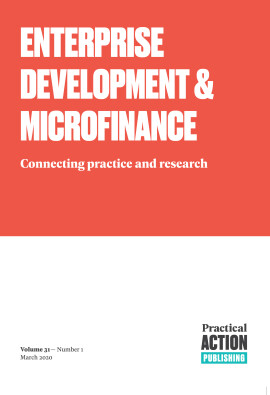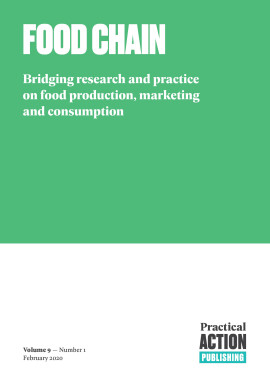A modified method to determine the value for sanitation: Case study on the willingness to pay for sanitation in peri-urban households of Peru
This study employed the contingent valuation method to estimate the willingness to pay (WTP) of peri-urban households to improve the method of waste collection in the peri-urban communities of Peru. This was a first attempt at designing a WTP methodology for on-site sanitation to access the willingness to pay a monthly fee for the maintenance and running cost for different types of sanitation technology. The methodology included a ‘bidding game’ method to determine the community's value for sanitation by portraying how an individual will react in a realistic economy with fluctuating costs for materials and facility maintenance. The results indicated that participants valued sanitation and were willing to pay a higher monthly fee to obtain improved sanitation facilities. Results also showed gender differences in hygiene practices, affecting the preferred sanitation technology.Alberini, A. and Cooper, J. (2000) ‘Applications of contingent valuation method in developing countries’, FAO Economic and Social Development Paper 146: 1-63.
Curtis, V. and Cairncross, S. (2003) ‘Water, sanitation, and hygiene at Kyoto’, British Medical Journal 327: 3-4.
Gunatilake, H., Yang, J.C., Pattanayak, S. and Choe, K.A. (2007) ‘Good practices for estimating reliable willingness-to-pay values in the water supply and sanitation sector’, ERD Technical Note No. 23, Asian Development Bank, Manila, Philippines: 1-53.
Hogrewe, W., Joyce, S.D. and Perez, E.A. (1993) ‘The unique challenges of improving peri-urban sanitation’, WASH Technical Report No. 86: 1-61.
Inter-American Development Bank (IADB) (2010) Drinking Water, Sanitation, and the Millennium Development Goals in Latin America and the Caribbean, IADB Water and Sanitation Initiative, Washington, DC.
Solo, T.M., Perez, E. and Joyce, S. (1993) ‘Constraints in providing water and sanitation services to the urban poor’, Technical Report No. 85, Water and Sanitation for Health Project, US Agency for International Development, Washington, DC.
United Nations (2010) Millennium Development Goals, United Nations Summit, New York.
Whittington, D. (1998) ‘Administering contingent valuation surveys in developing countries’, World Development 26(1): 21-30.
Whittington, D. (2002) ‘Improving the performance of contingent valuation studies in developing countries’, Environmental and Resource Economics 22: 323-67.
Whittington, D., Lauria, D.T., Wright, A.M., Choe, K., Hughes, J.A. and Swarna, V. (1993) ‘Household demand for improved sanitation services in Kumasi, Ghana: A contingent valuation study’, Water Resources Research 29(6): 1539-60.
World Health Organization (WHO) and UNICEF (2010) Joint Monitoring Programme for Water Supply and Sanitation: Estimates for the Use of Improved Sanitation Facilities: Peru, World Health Organization, Geneva.
Alberini, A. and Cooper, J. (2000) ‘Applications of contingent valuation method in developing countries’, FAO Economic and Social Development Paper 146: 1-63.
Curtis, V. and Cairncross, S. (2003) ‘Water, sanitation, and hygiene at Kyoto’, British Medical Journal 327: 3-4.
Gunatilake, H., Yang, J.C., Pattanayak, S. and Choe, K.A. (2007) ‘Good practices for estimating reliable willingness-to-pay values in the water supply and sanitation sector’, ERD Technical Note No. 23, Asian Development Bank, Manila, Philippines: 1-53.
Hogrewe, W., Joyce, S.D. and Perez, E.A. (1993) ‘The unique challenges of improving peri-urban sanitation’, WASH Technical Report No. 86: 1-61.
Inter-American Development Bank (IADB) (2010) Drinking Water, Sanitation, and the Millennium Development Goals in Latin America and the Caribbean, IADB Water and Sanitation Initiative, Washington, DC.
Solo, T.M., Perez, E. and Joyce, S. (1993) ‘Constraints in providing water and sanitation services to the urban poor’, Technical Report No. 85, Water and Sanitation for Health Project, US Agency for International Development, Washington, DC.
United Nations (2010) Millennium Development Goals, United Nations Summit, New York.
Whittington, D. (1998) ‘Administering contingent valuation surveys in developing countries’, World Development 26(1): 21-30.
Whittington, D. (2002) ‘Improving the performance of contingent valuation studies in developing countries’, Environmental and Resource Economics 22: 323-67.
Whittington, D., Lauria, D.T., Wright, A.M., Choe, K., Hughes, J.A. and Swarna, V. (1993) ‘Household demand for improved sanitation services in Kumasi, Ghana: A contingent valuation study’, Water Resources Research 29(6): 1539-60.
World Health Organization (WHO) and UNICEF (2010) Joint Monitoring Programme for Water Supply and Sanitation: Estimates for the Use of Improved Sanitation Facilities: Peru, World Health Organization, Geneva.
Alberini, A. and Cooper, J. (2000) ‘Applications of contingent valuation method in developing countries’, FAO Economic and Social Development Paper 146: 1-63.
Curtis, V. and Cairncross, S. (2003) ‘Water, sanitation, and hygiene at Kyoto’, British Medical Journal 327: 3-4.
Gunatilake, H., Yang, J.C., Pattanayak, S. and Choe, K.A. (2007) ‘Good practices for estimating reliable willingness-to-pay values in the water supply and sanitation sector’, ERD Technical Note No. 23, Asian Development Bank, Manila, Philippines: 1-53.
Hogrewe, W., Joyce, S.D. and Perez, E.A. (1993) ‘The unique challenges of improving peri-urban sanitation’, WASH Technical Report No. 86: 1-61.
Inter-American Development Bank (IADB) (2010) Drinking Water, Sanitation, and the Millennium Development Goals in Latin America and the Caribbean, IADB Water and Sanitation Initiative, Washington, DC.
Solo, T.M., Perez, E. and Joyce, S. (1993) ‘Constraints in providing water and sanitation services to the urban poor’, Technical Report No. 85, Water and Sanitation for Health Project, US Agency for International Development, Washington, DC.
United Nations (2010) Millennium Development Goals, United Nations Summit, New York.
Whittington, D. (1998) ‘Administering contingent valuation surveys in developing countries’, World Development 26(1): 21-30.
Whittington, D. (2002) ‘Improving the performance of contingent valuation studies in developing countries’, Environmental and Resource Economics 22: 323-67.
Whittington, D., Lauria, D.T., Wright, A.M., Choe, K., Hughes, J.A. and Swarna, V. (1993) ‘Household demand for improved sanitation services in Kumasi, Ghana: A contingent valuation study’, Water Resources Research 29(6): 1539-60.
World Health Organization (WHO) and UNICEF (2010) Joint Monitoring Programme for Water Supply and Sanitation: Estimates for the Use of Improved Sanitation Facilities: Peru, World Health Organization, Geneva.
Alberini, A. and Cooper, J. (2000) ‘Applications of contingent valuation method in developing countries’, FAO Economic and Social Development Paper 146: 1-63.
Curtis, V. and Cairncross, S. (2003) ‘Water, sanitation, and hygiene at Kyoto’, British Medical Journal 327: 3-4.
Gunatilake, H., Yang, J.C., Pattanayak, S. and Choe, K.A. (2007) ‘Good practices for estimating reliable willingness-to-pay values in the water supply and sanitation sector’, ERD Technical Note No. 23, Asian Development Bank, Manila, Philippines: 1-53.
Hogrewe, W., Joyce, S.D. and Perez, E.A. (1993) ‘The unique challenges of improving peri-urban sanitation’, WASH Technical Report No. 86: 1-61.
Inter-American Development Bank (IADB) (2010) Drinking Water, Sanitation, and the Millennium Development Goals in Latin America and the Caribbean, IADB Water and Sanitation Initiative, Washington, DC.
Solo, T.M., Perez, E. and Joyce, S. (1993) ‘Constraints in providing water and sanitation services to the urban poor’, Technical Report No. 85, Water and Sanitation for Health Project, US Agency for International Development, Washington, DC.
United Nations (2010) Millennium Development Goals, United Nations Summit, New York.
Whittington, D. (1998) ‘Administering contingent valuation surveys in developing countries’, World Development 26(1): 21-30.
Whittington, D. (2002) ‘Improving the performance of contingent valuation studies in developing countries’, Environmental and Resource Economics 22: 323-67.
Whittington, D., Lauria, D.T., Wright, A.M., Choe, K., Hughes, J.A. and Swarna, V. (1993) ‘Household demand for improved sanitation services in Kumasi, Ghana: A contingent valuation study’, Water Resources Research 29(6): 1539-60.
World Health Organization (WHO) and UNICEF (2010) Joint Monitoring Programme for Water Supply and Sanitation: Estimates for the Use of Improved Sanitation Facilities: Peru, World Health Organization, Geneva.
Social acceptance and willingness to pay for a smart Eco-toilet system producing a Community-based bioenergy in Korea
Eom, Young Sook
Oh, Hyungna
Cho, Jaeweon
Kim, Jaai
Sustainable Energy Technologies and Assessments, Vol. 47 (2021), Iss. P.101400
https://doi.org/10.1016/j.seta.2021.101400 [Citations: 5]- Providing municipal faecal sludge management services: lessons from Bangladesh
- Webwatch
- A call to action: organizational, professional, and personal change for gender transformative WASH programming
- Menstrual hygiene management: education and empowerment for girls?
- WASH challenges to girls’ menstrual hygiene management in Metro Manila, Masbate, and South Central Mindanao, Philippines


